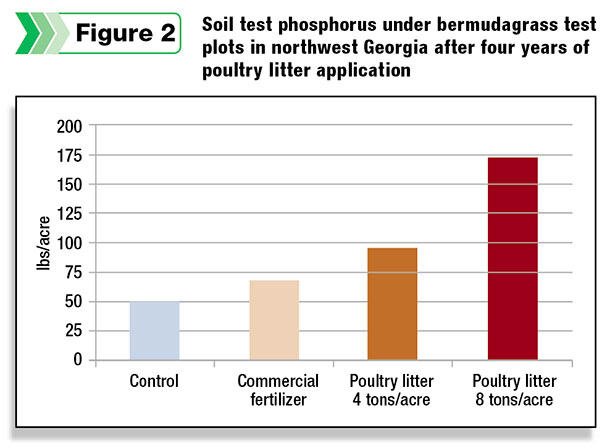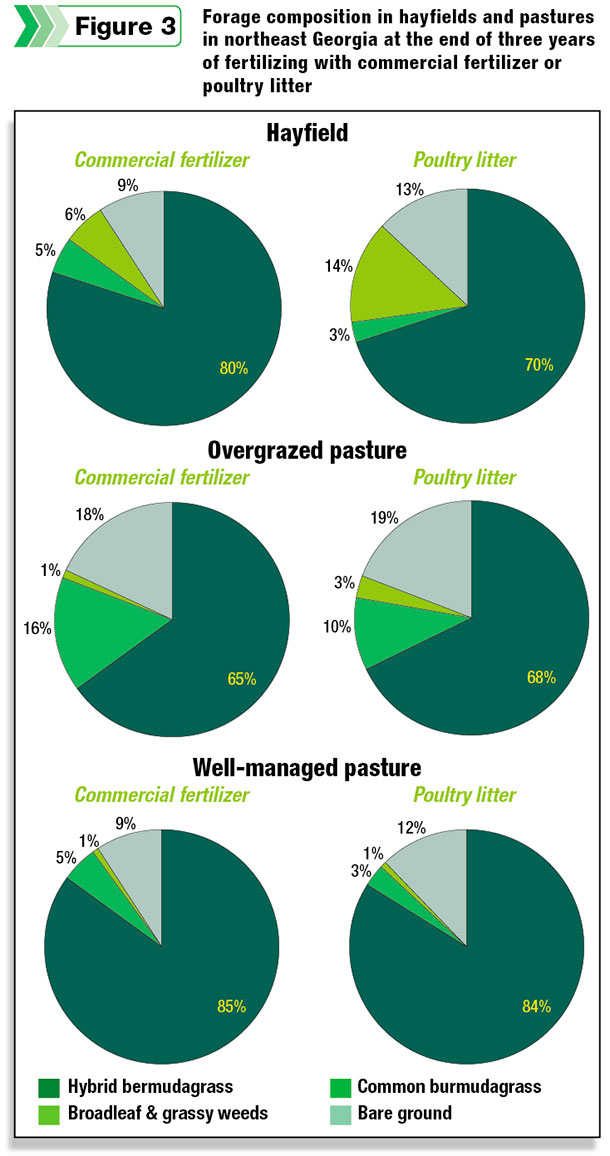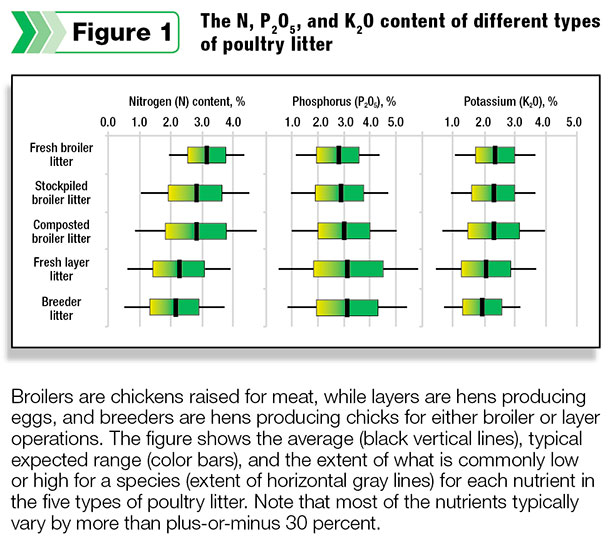What is in poultry litter?
Poultry litter is the mixture of bedding material, poultry manure, feathers and wasted feed that comes out of a poultry house. Commercial operations for producing meat or eggs from chickens, ducks, quail, turkeys and other fowl are common. Poultry litter from chicken operations will be the focus in this article, but most of the statements apply across other forms of poultry litter, as well.
From a forage producer’s point of view, the important content in poultry litter is the nitrogen (N), phosphate (P2O5), potash (K2O), calcium (Ca), magnesium (Mg), sulfur (S) and other nutrients essential for crop growth.
When poultry litter is applied to provide recommended rates of these nutrients to a forage crop, yields and quality are comparable to those situations where commercial fertilizer is used. Since poultry litter is expensive to transport, forage producers who have poultry houses nearby find it is a very economical source of nutrients.
However, not all poultry litter is created equal. Poultry litter can vary considerably in nutrient content. This a result of a variety of factors, including bird type, feed composition, type of bedding material, clean-out frequency, location within the house it came from, storage and handling practices, use of litter amendments and other factors.
Without describing how each of these factors affects the nutrient content of poultry litter, let it suffice to say that every lot of poultry litter differs so much that every lot should be tested (Figure 1).
Nutrient availability also differs
To further complicate matters, not all of the nutrients in poultry litter are immediately available to the plant. For example, only about 50 percent of the N in poultry litter will be available to the plant during the growing season in which it is applied. This is because the vast majority of N in poultry litter (about 89 percent) is in an organic form that must be broken down by micro-organisms before it can become available.
Since this breakdown is a biological process, the rate at which the N is made available is related to temperature and moisture. Moist and warm conditions allow for more release. Consequently, rapid green-up is observed after spring and summer applications.
In contrast, very slow N release occurs when poultry litter is applied in late fall or winter. The availability of the P2O5 and K2O in poultry litter is much greater than the availability of N. Approximately 90 percent of the P2O5 and nearly 100 percent of the K2O will be available in the growing season in which it is applied.
Poultry litter also has other beneficial components. Calcium carbonate, the fundamental molecule in agricultural lime, is in the mineral mixes commonly fed in poultry houses.
As such, poultry litter generally has a liming value that is about 1/10 the strength of agricultural lime. Forage growers who use poultry litter find it helps maintain soil pH and reduces the amount and frequency of lime applications.
The dark side of poultry litter
The use of poultry litter does have risks, though. One of the primary problems with the use (or at least overuse) of poultry litter is that the amount of P2O5 is very high relative to the N it supplies.
Since grasses normally require three to four times more N than P2O5, and poultry litter contains almost equal amounts of both, using poultry litter to meet the N needs of the forage will cause an overapplication of P2O5. Phosphorus can quickly accumulate to high levels in the soil (Figure 2).

High phosphorus levels in the soil do not pose a risk to the forage or livestock consuming the forage, but they do pose an environmental risk. Rainfall runoff from pastures and hayfields that have high soil-test phosphorus levels can impair water quality.
Most farm operations are required to have a nutrient management plan to prevent or minimize nutrient loading in runoff and surface waters. If phosphorus levels and other risk factors are high, producers are required to reduce poultry litter applications to a level equivalent to the P2O5 additions that would be recommended by the soil test or stop using poultry litter altogether.
Other products fed in or applied to the bedding material in poultry houses also end up in the poultry litter. One such problem is arsenic (As). Arsenic has historically been present in poultry litter as a consequence of feeding compounds such as roxarsone (3-nitro-4-hydroxyphenyl-arsenic acid) to prevent disease and improve weight gains.
Long-term applications of poultry litter from poultry houses where roxarsone was fed have been shown to result in higher concentrations of As in the soil relative to where poultry litter has not been applied (3 to 4 parts per million versus 1.5 ppm As).
However, these levels have always been below levels of environmental concern. In fact, the levels were well below the EPA’s loading limits established for land applications of municipal wastes (20 ppm As).
The company that sold roxarsone (Alpharma, a subsidiary of Pfizer Inc.) voluntarily suspended sales of roxarsone in 2011. Poultry litter also contains low concentrations of ionophore antibiotics, such as monensin (which is also fed to cattle under the trade name Rumensin). To date, there is no substantial evidence this poses any environmental risk.
In contrast, the presence of natural hormones (testosterone and estrogen-like compounds) in manure is a concern. These hormones can end up in surface and groundwater systems at concentrations that can have negative side-effects on aquatic species, as well as the wildlife and humans who consume the water.
Broiler litter contains approximately 50 parts per billion (ppb) of estrogen and 30 ppb of testosterone. Layer litter has about 70 ppb of estrogen and 25 ppb of testosterone. Measurements of runoff from pastures in Georgia treated with poultry litter have been observed to have concentrations of estrogen at 120 to 850 ppb and concentrations of testosterone at 50 to 920 ppb.
These concentrations are diluted substantially in most streams and rivers, but some research suggests that concentrations of these hormones in freshwater ecosystems or drinking water should be kept under 10 ppb to minimize risks.
Because of this, poultry litter and applications of other animal manures often are a favorite “whipping boy” on this issue, even though humans are a larger contributor of these hormones to the environment, either naturally via human waste or as a byproduct of medicinal additives (e.g., hormone replacement, birth control, etc.).
Weeds and poultry litter
One of the common complaints about using poultry litter is that weed pressure increases after application. It is a common myth that poultry litter has weed seeds in it. This is not true.
Studies in at least five states have conclusively shown that poultry litter does not contain viable weed seeds, regardless of whether it is fresh or composted. Poultry litter does change the soil and crop environment, though.
Because it cakes together, poultry litter consists of a variety of particle sizes. Most are smaller than a quarter-inch. However, some may be chunks larger than one’s fist.
These chunks can shade out forage plants growing underneath and provide a perfect environment for a weed to get a foothold. Any weed seed that might be blown on top or any seedling that can push its way from underneath one of these chunks would find a near-optimal mix of organic matter, nutrients and moisture.
A study conducted by the USDA-Agricultural Research Service confirmed farm reports that poultry litter sometimes increases weed pressure compared to the use of commercial fertilizer (Figure 3).

However, when poultry litter is applied to properly stocked and rotationally grazed pastures, the weed pressure is minimal, and the weeds were no worse than where commercial fertilizer had been used.
No substitute for good stewardship
Poultry litter has great benefits and significant risks. However, good managers can reap the benefits from poultry litter and all but eliminate the risks. Like most things in life, moderation is the key. FG

-
Dennis Hancock
- Assoc. Professor and Forage Extension Specialist
- University of Georgia
- Email Dennis Hancock












